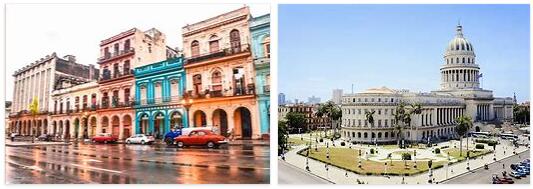
VARADERO
Varadero is the tourist center of Cuba, one of the most popular resorts in the Western Hemisphere. This picturesque resort town with many first-class hotels, clubs and restaurants is located on the northern coast of the province of Matanzas, on the Hicacos Peninsula, a two-hour drive from Havana (134 km).
First of all, tourists are attracted to Varadero by 22 kilometers of snow-white beaches washed by the clear and warm waters of the ocean. Local beaches are some of the most beautiful in the world: white sand and always clean, clear coastal water. They are protected from the sea by the largest coral reef in the Caribbean. The resort is well suited for families with children: there is a calm sea and a gently sloping bottom near the coast.
As a resort, it began to develop from the 30s of the XX century, when the Italian millionaire Dupont Nemours built the first hotel here with a golf course, a yacht pier and an airstrip. Other millionaires followed his example, appreciating the beauty of this place. In the fifties, the resort experienced a tourist boom, becoming the most popular vacation spot for Americans. In 1959, all private beaches were nationalized. Now most of the tourists to Varadero are Europeans and Canadians.
Life here is seething day and night. During the day, tourists are waiting for sandy beaches of hotels and crystal water, outdoor enthusiasts – yacht trips, deep sea fishing and excursions to various exotic corners of Cuba, numerous diving centers, go-karting, golf and much more. In the evening, nightclubs, discos and restaurants, which Varadero is so famous for, open.
Climate
The climate is subtropical, softened by warm sea currents washing its shores. The maximum temperature of 35C occurs in August, while in January it can drop to 19°C.
Favorable conditions for beach recreation and swimming persist throughout the year. The high season lasts from December to April – the coolest and driest time of the year (it can be fresh in the evening); hurricanes are possible in August – October.
HAVANA
Havana – one of the most beautiful cities in the New World – is located in the north-west of the island and dates back to 1515. The city is very picturesque – magnificent mansions of the period of Spanish domination are adjacent to buildings in the style of “developing socialism”, ultra-modern skyscrapers – with dilapidated suburban houses, and pompous hotels in the coastal part of the city – with numerous churches. When the night comes, the discos and bars open their doors and Havana becomes something special, unique – with these Caribbean musical rhythms sounding from every corner.
The historical core of the city – Old Havana, is located around the port and the Havana Bay. Many old bright facades were put in order and all kinds of small hotels, cafes and restaurants were built. The center of old Havana with narrow streets of colonial times is the very history of the country and its capital (in 1982 it was declared a world historical heritage by UNESCO). The catalog of historical monuments of the old center of Havana alone includes over 900 objects. The narrow strait into the harbor is guarded on both sides by the ancient fortresses of Castillo del Morro (1589-1630), Castillo de la Punta and the lighthouse (1845), and the western shore is guarded by the forts of La Cabaña and La Real -Fuersa (1555-77, the oldest fortification in America), which now houses the Museum of Ancient Weapons. From Havana’s Malecon promenade (a favorite place for walking citizens and arena for traditional February carnivals), stretching almost under the walls of the forts, begins the main street of Havana – Paseo del Prado or simply Prado. The boulevard is considered one of the main architectural monuments of old Havana – paved with marble slabs and lined with trees, built up with colorful mansions in the old Spanish style, today it is one of the favorite vacation spots. The Prado houses the building of the National Capitol, built in the image and likeness of Washington, now it houses the Academy of Sciences of Cuba, the National Library of Science and Technology and the Museum of Local History. Nearby are the former presidential palace (now the Museum of the Revolution), the governor’s palace (now the Museum of the City of Havana) and the Granma memorial.
To the west of the bay lie the small chapel of El Templete (1828) on the site of the founding of the city, as well as the beautiful architectural complexes of the Plaza de Armas (Arms Square) with the majestic building of the Palacio de Los Capitanes Generales, Plaza de la Catedral (Cathedral Square) with the Cathedral of St. Christopher (1748-77), Plaza Vieja (Old Square) and Trocadero Street with the building of the Palace of Fine Arts – one of the best art museums in the Western Hemisphere.
In the new part of Havana – on the promenade of the Vedado district, along the Malecon promenade and La Rampa street, there are numerous villas, hotels for every taste and with excellent service, as well as well-equipped beaches. On the hills above Vedado are the University of Havana (1728), Revolution Square with the José Marti Memorial (1996) and an observation deck 138 m high, the Palace of the Revolution, administrative buildings and the National Library, and on the shore of the bay – one of the largest in world of aquariums. Along the bay in the Cubanacan region stretches a whole series of beautiful beaches and yacht clubs, as well as a large amusement park, and beyond the Almendares River – an area of chic mansions and luxury hotels Miramar.
Climate
From May to October it is hot and rainy here. You can relax in Havana almost all year round. The peak of the tourist season falls on the winter period from December to April.